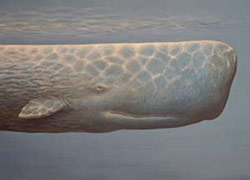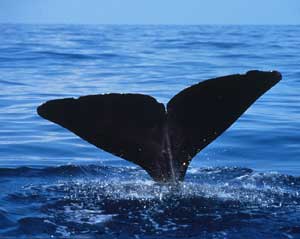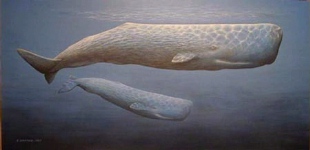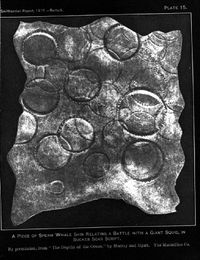Sperm Whale
2007 Schools Wikipedia Selection. Related subjects: Mammals
| iSperm Whale | ||||||||||||||||
|---|---|---|---|---|---|---|---|---|---|---|---|---|---|---|---|---|
 Scarred Giant — Artist: Chris Harman  Size comparison against an average human
|
||||||||||||||||
|
|
||||||||||||||||
| Scientific classification | ||||||||||||||||
|
||||||||||||||||
|
|
||||||||||||||||
| Physeter macrocephalus Linnaeus, 1758 |
||||||||||||||||
 Sperm Whale range (in blue)
|
The Sperm Whale (Physeter macrocephalus) is the largest of all toothed whales and is the largest toothed animal alive, measuring up to 18 metres (60 ft) long. The whale was named after the milky-white substance spermaceti found in its head and originally mistaken for sperm. The Sperm Whale's enormous head and distinctive shape, as well as its central role in Herman Melville's Moby-Dick, have led many to describe it as the archetypal whale. Partly due to Melville, the Sperm Whale is commonly associated with the mythological Leviathan of the Bible.
Historically the Sperm Whale has also been known as the Common Cachalot. The word cachalot is originally Portuguese (cachalote), probably coming from cachola, a colloquial term for head. Sperm Whales were hunted until recently in the Portuguese atlantic archipelago of Azores. The Sperm Whale is also the state animal of Connecticut.
Physical description
The Sperm Whale is exceptional for its very large head, particularly in males, which is typically one-third of the animals' length. Indeed, the species name macrocephalus is derived from the Greek for "big head" (strictly: long head). In contrast to the smooth skin of most other large whales, the skin on the back of the Sperm Whale is usually knobbly and has been likened to a prune by whale-watching enthusiasts . They are uniformly grey in colour though may appear brown in sunlight (the "Great White Whale" of Melville's novel, if such an animal existed, was an albino, and white sperm whales have been reported in reality as well). Perhaps unsurprisingly, the brain of the Sperm Whale is the largest and heaviest known of any modern or extinct animal (weighing on average 7 kg (15 lb) in a grown male). However, the brain is not large relative to body size.
The blowhole is situated very close to the front of the head and shifted to the whale's left. This gives rise to a distinctive bushy blow angled forward. The dorsal fin is set about two-thirds of the way down the spine and is typically short and shaped like an equilateral triangle.

The fluke is also triangular and very thick. Flukes are lifted very high out of the water before a whale begins a deep dive.
Sperm Whales have 20–26 pairs of cone-shaped teeth in their lower jaw. each 8-20 cm (3-8 in) long. Each tooth can weigh as much as one kilogram. The reason for the existence of the teeth is not known with certainty. It is believed that they are not necessary for feeding on squid (see Feeding below) and indeed healthy well-fed Sperm Whales have been found in the wild without teeth. The current scientific consensus is that the teeth may be used for aggression between males of the same species. This hypothesis is consistent with the conic shape and wide spacing of the teeth. Rudimentary teeth are also present in the upper jaw, but these rarely open into the mouth.
Sperm Whales are amongst the most sexually dimorphic (that is, males and females differ greatly) of all cetaceans. Males are typically 30%–50% longer (16–18 m, 52-59 ft) than females (12–14 m, 39-46 ft) and weigh about twice as much (50,000 kg vs. 25,000 kg, 55 short tons vs 27.5 short tons). At birth both males and females are about 4 m (13 feet) in length and 1,000 kg (1 tonne) in weight. Due to extensive whaling, Sperm Whale size has decreased dramatically, mostly because the largest males were killed first and most intensively, for they had more spermaceti (spermaceti oil was of great value in the 18th and 19th century - see below). In a Nantucket museum there is a jawbone of a sperm whale which is 5.5 m (18 ft). The jawbone makes up to 20%-25% of the sperm whale's overall body length. Thus this whale might have been 28 m (90 ft) long, weighing around 150 metric tons (165 short tons). Another evidence of large bulls of the past resides in New Bedford museum, a 5.2 metres (17 feet) jaw of a bull that could have been about 25.6 metres (84 feet) long, weighing about 120-130 tons. In addition, log books found in the Nantucket and Bedford museums are filled with references to bulls that were, considering the amount of oil they yielded, about the same size as these two examples. Today, Sperm Whale males do not usually exceed 18 m (60 feet) in length and 52 metric tons (57 short tons) in weight.
In 1820, a sperm whale estimated to be about 25.9 m (85 ft) long attacked a Nantucket whaling ship Essex. Only 8 out of the 20 sailors managed to survive and be rescued by other ships.
Sperm Whales are a prime example of a species that has been K-selected, which is to say that the species is believed to have developed primarily under very stable environmental conditions. This relatively "easy" evolution has led them to have a low birth rate, slow maturation and high longevity. Females give birth once every four to six years, and the gestation period is at least 12 months and possibly as long as 18 months. Nursing takes place for two to three years. In males, puberty lasts for about ten years between the ages of about 10 and 20. Males continue to grow into their 30s and 40s and only reach their full size when about 50 years old. Sperm Whales live for up to 80 years.
The Sperm Whale holds some absolute world records:
- Largest known toothed mammal ever.
- Deepest dive by a mammal (sperm whales have been found in depths of 2,200 metres (7,200 feet), tangled in telegraph cables).
- Largest brain of any living creature on Earth. The brain of a mature sperm whale weighs 7 kg (15 pounds), though there have been specimens with 9 kg (20 pound) brains.
- Thickest skin. On back and head, sperm whale's skin (not including subcutaneous fat) is sometimes up to 35 centimetres (14 inches) thick.
- Largest living predator on Earth.
According to a 2003 National Geographic article, Sperm Whales are said to be the loudest of all animals ("about as loud as a rifle shot three feet from your ear").
Taxonomy
The Sperm Whale was categorized first by Linnaeus in 1758 who recognised four species in the Physeter genus. Experts soon realised that just one such species exists. In most modern publications the Sperm Whale is classified as the sole species in the family Physeteridae (and thus the only species in its genus). The sperm whale family is sometimes (see, e.g. ) treated as a superfamily, Physeteroidea. This superfamily contains only two other species—the Pygmy Sperm Whale and the Dwarf Sperm Whale. These two whales belong to the family Kogiidae.
Mead and Brownell (1993, see ), however, list all three species in the family Kogiidae, give the Sperm Whale the binomial name Physeter catodon and dispense with the superfamily.
The following is an extract from Melville's Moby-Dick, in which he expatiates about the naming and common lore surrounding the Sperm Whale:
"This whale, among the English of old vaguely known as Trumpa whale, and the Physeter whale, and the Anvil Headed whale, is the present Cachalot of the French, the Pottfisch of the Germans, and the Macrocephalus of the Long Words. [text omitted] It is chiefly with his name that I now have to do. Philologically considered, it is absurd. Some centuries ago, when the Sperm whale was almost wholly unknown in his proper individuality, and when his oil was only accidentally obtained from the stranded fish; in those days spermaceti, it would seem, was popularly supposed to be derived from a creature identical with the one then known in England as the Greenland or Right Whale. It was the idea also, that this same spermaceti was that quickening humor of the Greenland Whale which the first syllable of the word literally expresses. In those times, also, spermaceti was exceedingly scarce, not being used for light, but only as an ointment and medicament. It was only to be had from the druggists as you nowadays buy an ounce of rhubarb. When, as I opine, in the course of time, the true nature of spermaceti became known, its original name was still retained by the dealers; no doubt to enhance its value by a notion so strangely significant of its scarcity. And so the appellation must at last have come to be bestowed upon the whale from which this spermaceti was really derived." [from Melville's Moby Dick, Chapter 32, named "Cetology"]
Sperm Whales are believed to have diverged from other toothed whales early in the evolution of the suborder—around twenty million years ago (see for details).
Spermaceti
Spermaceti is the semiliquid, waxy substance found in the head of the Sperm Whale. The name derives from the late Latin sperma ceti (both words actually loans from Greek) meaning "sperm of the whale" (strictly, "sperm of the sea monster"). The common name for the species is actually an apocopation of Spermaceti Whale. The substance is not, of course, the whale's semen; it was mistaken for such by early whalers. Spermaceti is found in the spermaceti organ or case in front of and above the skull of the whale and also in the so-called junk which is right at the front of the whale's head just above the upper jaw. The case consists of a soft white substance saturated with spermaceti. The junk is a more solid substance.
The precise function of spermaceti and the organs it fills is not known, but at least three (not necessarily mutually exclusive) hypotheses exist:
One hypothesis (detailed in ), incidentally discussed in Moby-Dick by Melville, is that the case evolved as a kind of battering ram for use in fights between males. This hypothesis is consistent with the well-documented sinking of the ships Essex and Ann Alexander due to attacks by Sperm Whales estimated to weigh only one-fifth as much as the ships.
A second, more long-standing suggestion is that the case is an aid to the whale in controlling buoyancy. The density of the wax could be increased by cooling it with water brought in through the blowhole, helping the whale to sink. Conversely, forcing water out through the blowhole again would cause the spermaceti to reheat, become less dense and aid floating. This popularly quoted theory has recently lost some credence. Research suggests that no capillary effect would be extensive enough to change drastically the buoyancy of a 50-tonne whale. (See Ted Cranford's homepage for a list of papers detailing the research.)
A third possibility is that the case is used as an aid to echolocation, see melon. The shape of the organ at any given time is likely to focus or widen the beam of emitted sound. The sound waves may be so focused that they act as a kind of stun gun, temporarily disabling prey. Active research into all these possibilities continues.
Spermaceti was much sought after by 18th-, 19th- and 20th-century whalers. The substance found a variety of commercial applications, such as watch oil, automatic transmission fluid, lubricant for delicate high-altitude instruments, cosmetics, additives in motor oils, glycerine, rust-proofing compounds, detergent, chemical fibres, vitamins and 70 or more pharmaceutical compounds.
Spouting, and breathing
Whales breathe air at the surface of the water through a single, s-shaped blowhole. The blowhole is located on the left side of the front if its huge head. They spout (breathe) 3-5 times per minute at rest, but the rate increases to 6-7 times per minute after a dive. The blow is a noisy, single stream that rises up to 50 feet (15 m) above the surface of the water and points forward and to the left of the whale at a 45° angle.
Feeding, behaviour and diving
Sperm Whales, along with bottlenose whales, are the deepest-diving mammals in the world. They are believed to be able to dive up to 3,000 metres in depth and 2 hours in duration to the ocean floor. More typical dives are around 400 metres in depth and 30–45 minutes' duration and generally moves in a northerly direction. They feed on several species, in particular giant squid, octopuses and demersal rays. Almost all that is known about deep sea squid has been learned from specimens found in captured Sperm Whale stomachs. Stories about titanic battles between Sperm Whales and giant squid which are believed to reach up to 13 m (44 ft) are perhaps the stuff of legend. However, white scars on the bodies of Sperm Whales are believed to be caused by squid. It is also hypothesised that the sharp beak of a consumed squid lodged in the whale's intestine leads to the production of ambergris, analogous to the production of pearls. Sperm Whales are prodigious feeders and eat around 3% of their body weight per day. The total annual consumption of prey by Sperm Whales worldwide is estimated to be about 100 million tons — a figure greater than the total consumption of marine animals by humans each year .
The only predator that attacks sperm whales, besides man, is the orca. Large, roving pods of orcas frequently target groups of females with young, usually trying to separate the sperm whale calf and kill it. Oftentimes, the female sperm whales can repel these attacks by forming a circle with their calves in the centre and then violently thrashing their tail flukes, so that no orca can penetrate the formation. If the orca pod is extremely large, they may sometimes also kill adult females. Large bull sperm whale have no predators, as even orcas could be killed by these aggressive, powerful creatures.
In addition, long-line fishing operations in the Gulf of Alaska have complained that numerous Sperm Whales have taken advantage of their fishing operations to eat desirable species straight off the line, sparing the whales the need to hunt them themselves .
The physiology of the Sperm Whale has several adaptations to cope with drastic changes in pressure when diving. The ribcage is flexible to allow lung collapse, and the heart rate can decrease to preserve oxygen supplies. Myoglobin stores oxygen in muscle tissue. Blood can be directed towards the brain and other essential organs only, when oxygen levels deplete. The spermaceti organ may also play a role (see above).
While sperm whales are well adapted to diving, repeated dives to great depths do have long term effects on the whales. Skeletons of sperm whales show pitting of the bones that is often a sign of decompression sickness in humans. Skeletons of the oldest whales showed the most extensive pitting, whereas skeletons of sperm whale calves showed no damage. This damage may indicate that sperm whales are susceptible to decompression sickness, and sudden surfacing could be lethal to them.
Between dives, the Sperm Whale will come up to the surface for breath and remain more or less still for eight to ten minutes before diving again.
Because of the great depths to which they dive, Sperm Whales sometimes drown when entangled in transoceanic telephone cables.
The social structure of the Sperm Whales species divides on sexual lines. Females are extremely social animals, a trait believed to derive from their relatively simple evolutionary path. Females stay in groups of about a dozen individuals and their young. Males leave these "nursery schools" at somewhere between 4 and 21 years of age and join a "bachelor school" with other males of a similar age and size. As males grow older, they tend to disperse into smaller groups, and the oldest males typically live solitary lives. Yet mature males have been stranded on beaches together, suggesting a degree of co-operation not yet fully understood.
Distribution
The Sperm Whale is among the most cosmopolitan species in the world, and is found in all the oceans and the Mediterranean Sea. The species is relatively abundant from arctic waters to the equator. Populations are more dense close to continental shelves and canyons, probably because of easier feeding. Sperm Whales are usually found in deep off-shore waters, but may be seen closer to shore in areas where the continental shelf is small.
Population and hunting
The total number of Sperm Whales throughout the world is unknown. Crude estimates, obtained by surveying small areas and extrapolating the result to all the world's oceans, range from 200,000 to 2,000,000 individuals. Although the Sperm Whale was hunted for several centuries for its meat, oil and spermaceti, the conservational outlook for Sperm Whales is brighter than that for many other whales. Although a small-scale coastal fishery still occurs in Indonesia, they are protected practically worldwide. Fishermen do not catch the deep-sea creatures that Sperm Whales eat, and the deep sea is likely to be more resistant to pollution than surface layers.
However, the recovery from the whaling years is a slow process, particularly in the South Pacific, where the toll on males of a breeding age was severe.
Watching Sperm Whales
Sperm Whales are not the easiest of whales to watch, due to their long dive times and ability to travel long distances underwater. However, due to the distinctive look and large size of the whale, watching is increasingly popular. Sperm Whale watchers often use hydrophones to listen to the clicks of the whales and locate them before they surface. Popular locations for Sperm Whale watching include the picturesque Kaikoura on New Zealand's South Island, where the continental shelf is so narrow that whales can be observed from the shore, and Andenes and Tromsø in arctic Norway. Dominica is believed to be the only Caribbean island with a year-round residential pod of females and calves.
In the news
In July 2003 a huge blob of white flesh was found washed up on a beach on the coast of southern Chile. The 12-metre-long (40 ft) mass of gelatinous tissue gave rise to speculation that a previously unknown giant octopus had been discovered. However, researchers at the Museum of Natural History, Santiago concluded that the mass was in fact the innards of a Sperm Whale, a conclusion drawn by looking at the dermal glands. When a Sperm Whale dies, its internal organs rot, until the animal becomes little more than a semi-liquid mass trapped inside the skin. In this case, the skin will eventually burst, causing the internal mass to float free and eventually wash up on the beach .
Dead Sperm Whales float towards shore quite often. Apart from the disposal issues identified above, beach managers fear that sharks, in particular the Great White Shark, will be attracted towards the beach by the rotting flesh, and potentially cause danger to beach users. For this reason, dead Sperm Whales are often towed out to sea before they become properly beached. This occurred twice in May 2004, once off Oahu in Hawaii where a dead whale was towed out 35 miles to sea but floated back to shore two days later .
Exploding whales
Perhaps the most famous piece of Sperm Whale lore dates from 1970, when a long-dead, 8 short ton (7.25 tonne), 45 foot (13.7 m) long specimen came to the beach south of Florence, Oregon. For a time, it was a curiosity to local residents. As the beach is public right-of-way, it was the duty of the Oregon State Highway Division to dispose of it. They filled the animal with a half-ton of dynamite. On Thursday, November 12, the dynamite was set off, but the blast did not go toward the Pacific as planned. No one was hurt, but a car was crushed by falling blubber. Onlookers were covered with noxious-smelling bits of dead whale .
January 2004 saw a more dramatic entry of the Sperm Whale into the global media spotlight. A dead specimen of the whale, 17 metres long and weighing 50 tonnes, had washed up on a local beach in Tainan City, Taiwan. On being transported to a university in the city, gas pressure from decomposition built up inside the body, causing an explosion. Nobody was hurt, but blood and entrails were spread over several cars and surrounding pedestrians .



